It isn't autumn, yet, but it has sometimes felt like winter, despite really being summer! There were loads of rowan berries around the car park in Aviemore, where we met up for our August walk. The rowan berries really make you think that autumn and winter are just around the corner. The berries seem to be especially plentiful this year. Most people think this means there will be a hard winter. Oddly, the opposite is believed in more northern countries like Finland. They believe that the rowan will be unable to bear a heavy crop of fruit and a heavy fall of snow in the same year - so lots of berries means there will not be much snow.
The truth is that the formation of the berries is governed by the weather in the previous summer. Warmer summers will give rise to many more berries the next year. In essence, Rowans are no better at predicting the weather than the BBC.
The Gaelic for rowan is Caorann, sometimes spelled Caorunn. This is, of course, a type of gin. Remarkably, rowans were planted near houses to ward of witches. All the witches I know, really like gin!
In neo-druidism (yes, there is such a thing), rowan
is said to be a portal tree. It marks where you leave one place to go to another.
That's lucky, because we left the car park and went onto the start of the Aviemore orbital footpath. We wouldn't have been able to do that unless we had found the rowan tree portal.
It wasn't long until we reached another portal - this was an underpass which allows people to walk from Aviemore to the Craigellachie National Nature Reserve. It was installed when the A9 was improved. The NNR is famous for being the site of a peregrine falcon nest. We did not go through the portal, but carried on following the path.
Into every life a little rain must fall and it fell into our lives shortly after we passed the underpass.
At the very first fork in the route, some of our number decided to wander off. You might note that one of those wandering off was a guest walker - Chris. He can be forgiven, the others, particularly Jimmy, cannot be excused for leading Chris astray.
The sensible ones followed the walk leaders and stuck to the proper path.
Adjacent the path was an extensive area of Devil's-bit Scabious. This is quite common in the Highlands, but can be locally scarce in other parts of the country. It was once used to treat scabs and scars caused by Bubonic Plague! It has a black, truncated root and it was said that the devil had bitten the root, angry that the plant could be used as a medicine against plague.
Nothing could divert us from our path, except for a diversion.....
....or a large puddle! Note the grace and elegance displayed by the other of our guest walkers, Sandra.
I thought it was a little early for sweeties, and, indeed, it was. It was actually time for Jimmy to hand round healthy snacks of freshly picked peas from his garden.
Everybody dug in.
Someone else had already dug into mine, so I didn't eat them all!
For the avoidance of doubt, Maureen held the pea pod open for me to take the photo. The nail varnish was absolutely not mine - I prefer a darker shade.
After we had all had a pea, we ventured further into Milton Woods.
The woods are mainly birch and quite young in places, which would suggest that grazing pressures are not that high. I have to say that I find thick woods like this quite fascinating. You probably wouldn't have to go too far away to disappear from view altogether
The rain had long gone and there was blue sky above.The major archaeology hereabouts relates to an old corn and grain mill, which gives the name to the Mill Town (Milton) woods. Other archaeology includes this neolithic Xbox controller that I spotted in the woods.
It was close to some chanterelles. These are much sought after by chefs and they can command a high price. They are also the state mushroom of California. The magic mushroom is, presumably, the altered state mushroom.
I stopped to take a photo of a white Devil's-bit scabious. I had never seen a white one before and they are quite rare. It took me ages to get a decent enough photo. Isn't it dainty?
By the time I had done that, they were all disappearing into the distance.
Soon, I had completely lost them and had to phone Sharon to find out which route they had taken. I wasn't really panicking. Honest. Even worse, neither were they, indeed, some of them didn't notice my absence. Makes you realise how insignificant you really are.
I finally caught up with them beside a small burn. As you might expect, there were lots of alder trees along the edges of the burn. They appeared to be infected by some sort of disease. In fact these were blister galls caused by another insignificant mite, Eriophyes laevis.
The shady burn is called the Steallan dubh - the black spout or cataract. It wasn't much of a cataract, to be honest.
It did, however, have a bridge, so we got a bridge photo.
Maybe sometimes, the burn rages a bit like a cataract to justify the name. It also joins the Milton Burn and both watercourses drove a couple of grain mills in the past.
As we were stopped for a photo, we also had time for some sweeties, courtesy of Maureen.
I'm almost positive that I have these photos in the right order. Robin clearly has a mouthful of chocolate toffee in this image.
Seconds later, and here he is going for seconds, like a striking cobra.
Back to nature and white flowers - some nice, white foxglove blooms. You would expect the Gaelic translation to be fairly literal, but no, the Gaelic is, perhaps, even more cute - Lus nam ban-sithe - The fairy woman's plant. Sithe is pronounced shee - which is where banshee comes from.
The next plant to catch the eye was a Hawkbit, I think. This could be one of a number of Hawkbits, but I'm guessing Autumn Hawkbit.
There was a lot of it!
Aviemore is also growing and has been since it became a railway junction in 1898, although there is plenty of evidence of occupation dating from the Bronze Age. An Aghaidh Mhor is the Gaelic name and it really means the big mountain face or cleft. It is not clear whether that relates to Craigellachie, which is quite cliff like, or whether it is more to do with the ever present views of the Cairngorm Massif. It can be seen from everywhere in the town, even these new developments, despite the haze.
From the built up edges, we moved across grass and heathland. Lots of purple heather out at the moment and the grass has set and sown seed.
We moved into some nice broadleaved woodland, heading towards the River Spey.
Our passage had not gone unobserved.
The route took us under two railway lines. The first is the main line from Perth to Inverness. The second is the line from Aviemore to Forres. This closed in 1965, but the line is still used by steam trains from the heritage Strathspey Railway. This underpass allowed the wee burn to get under the line as well Dinosaurs and other users.
It is quite a fine structure.
By now we were on the Speyside Way and the National Cycle Network. Where these two networks join, a series of seven galvanised sculptures were erected. These represent seed heads from the local vegetation and they also reference railway engine and bicycle wheels. They are a fusion of nature and machine, made by Joseph Ingleby, who is based in Glasgow.
It wasn't long before we stopped for lunch on the banks of the Spey - Uisge Spe - in Gaelic. The origin of the name is lost and Spey does not appear on maps until the mid 15th Century. It is the 8th longest river in Britain and the 2nd longest and the fastest flowing in Scotland. It was nice and placid where we sat down.
Normally I would take a few photos of people doing something odd with their food or, more usually, a group photo at lunch time. However, our guest walkers, Sandra and Chris (well Sandra) took lots of photos of us all sitting by the river, so here they are for your delight.
It really was a bit of a literary and artistic lunch.
We may only have had a tuna roll each, but it instantly brought to my mind Dali's painting of Tuna Fishing, which, of course, personifies the limited universe that we live in.
We were happy with that.
Were Dave and Sandra really ecstatic about their choice of sandwich, or was Dave perhaps a little underwhelmed and Sandra told him not to exhibit "these tones, but let us strike up more agreeable ones". You will all, of course, recognise that as a line from Schiller's Ode to Joy.
Liz was looking quite enigmatic, perhaps even Mona Lisa like.
Maureen and the Smiths looking like Shady Characters. This is a book which you will all know about is the secret life of punctuation, symbols & other typographical marks.
Despite the resemblance to Male and Female painted by Robin's old uncle Jackson, both Susan and Robin have fallen into Robin's well known obsession with manspreading! This is quite appropriate, inasmuch as there is some debate in artistic circles about which of the figures in the painting is the male or the female. The figure on the left of the painting is assumed to be female, given the prominent eyelashes and the decidedly curvy torso. We all know how much Susan would sign up to that description. The figure on the right of the painting is assumed to be the man because it features a long column of numbers!
Sandra and Chris looking rather more D H Lawrence than one of the Bronte sisters!
This rather reminded me of Le Dejeuner sur l'herbe by Manet, although all the young ladies managed to keep their clothes on!
After that cultural luncheon, we walked along the edge of the Spey Valley golf course. Spey Valley is locally quite contentious. Badenoch and Strathspey is the administrative area within which Aviemore sits. Badenoch is an Anglicisation of Baideanach, which means the drowned land. The capital of Badenoch was Kingussie and much of the low lying land along that stretch of the Spey north and south of Kingussie is prone to flooding.
Strathspey is a straightforward translation of Srath Spe, meaning the wide valley of the Spey. So, when this was Anglicised into the Spey Valley, it was seen as a further, and unnecessary, step away from the perfectly serviceable Strathspey, which is much closer to the original Gaelic Srath Spe. It is by such little steps that culture and heritage in the Highlands is eroded.
Anyway, the golf course is quite splendid, if a bit on the long side for the likes of me.
Here we are walking down the 18th, beside the river and with a fine view of the hills beyond.
We were a little way from the remnant of the Caledonian pine forest, nearer the mountains. There was a tiny forest growing out of an old fence post, but not a patch on the real thing! Thanks to Maureen buying me a book of Highland folk tales for my birthday, I now know why the Rothiemurchus forest survived when so much of the Caledonian forest disappeared.
To cut the original story short, the King of Norway was jealous of the great forests of the King of Scotland, so he sent his daughter to Skye to learn some magic, which she did. She had a little book of magic. She was reading that, when a cloud appeared over her and she climbed out of the window and into the cloud, which drifted over the sea. All the time she sang a spell to the cloud. When it reached Caithness, lightning shot out of the cloud and set light to the great forests. The princess continued with her cloud wreaking destruction on the forests of Scotland. People fled in front of the cloud, as you might expect. On reaching Rothiemurchus, they begged an old, wise man for help. He demanded all their silver. He also made them put all their livestock on one side of the strath and the calves and lambs on the other.
The wise man made a silver arrow out of the peoples treasures. The young beasts called to their mothers and the mothers called back, making a huge noise. The princess peered out of the cloud to see what the commotion was about and the wise man shot and killed her with the silver arrow. The cloud became mist and evaporated and so Rothiemurchus forest was saved.
We were in no need of silver arrows and there were still plenty of interesting trees along the banks of the river.
There was also a white lupin by the river.
Not all the trees that escaped the princess's depredations stayed upright. This one provided a photo opportunity. They all lined up dutifully, except for Jimmy who went out on a limb.
In many ways the tree was more interesting than the people behind it! There was a huge community of mosses and lichens on the bark. Just look at this Lobaria scrobiculata!
Or, this small Parmotrema perlatum!
There's even some Evernia prunastri.
I'll bet you can hardly contain yourselves after that, so here's a calming couple of photos of the sun through green leaves. Some of the lichens may even have been properly identified.
Once we were out of the woods by the river, we crossed over grassland, back towards Aviemore and the railway line.
From grassland onto track and we nearly squished this beautiful Small Copper butterfly. He is most probably a he, because the males often find a patch of bare ground or a stone and then they sit and wait for a female to pass. They can be remarkably aggressive towards other insects, chasing them away and then returning to their favoured spot.It isn't often you see cows with big horns, especially when they aren't big hairy heilan' coos. Maybe it was just a horny cow.Without getting into the horniness of cows, we were lucky to be back at the start of the walk. It is somewhat ironic that a group with a combined age of close to a millennium, were parked at a Youth Hostel!That was the end of another fine walk, courtesy of Susan and Robin. Tea and cakes was at Tastes of Tomatin for the second time in a row. Very good it was too. Well done to the Pollocks for organisation and to Sandra and Chris for putting up with our idiosyncrasies.


















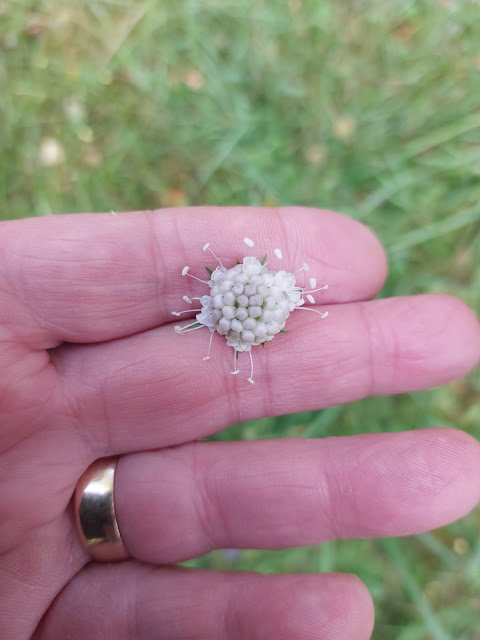





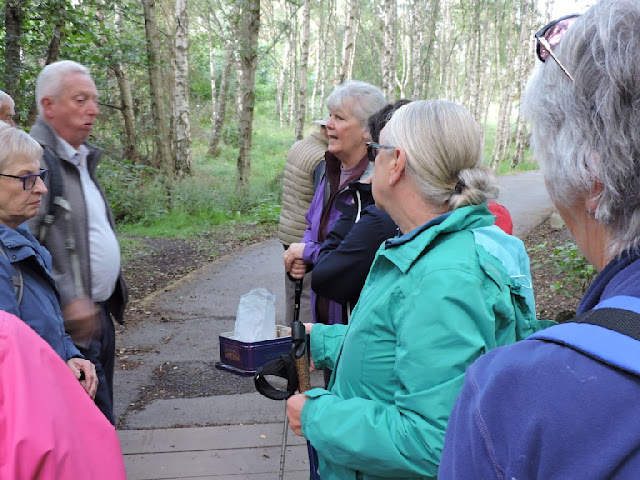













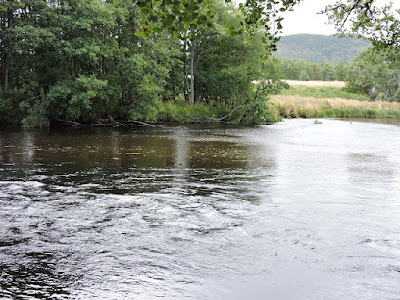







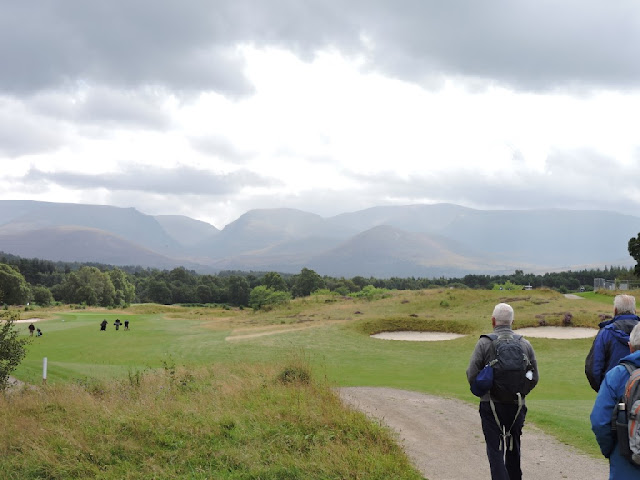









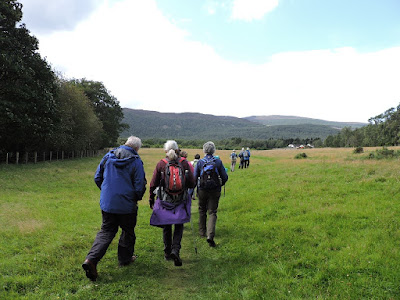




0 Comments:
Post a Comment
<< Home